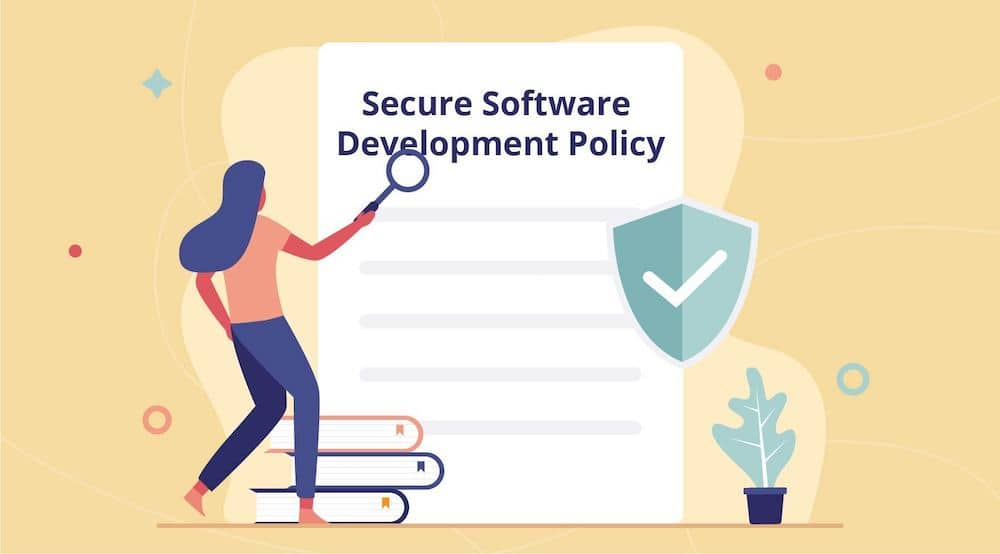10 Software Development Security Best Practices
Contents
Software development security is paramount in today’s digital landscape, with the proliferation of applications and the constant threat of cyberattacks. This article presents 12 vital best practices for software development security, empowering developers to build applications that are secure, resilient, and trustworthy. By utilizing these practices, organizations can effectively mitigate risks, instill customer trust, and safeguard valuable digital assets.
Spanning a range of technical and procedural considerations, from secure coding practices to thorough vulnerability assessments, this comprehensive guide equips developers with the necessary tools and insights to fortify their applications against ever-evolving threats and vulnerabilities. Whether you’re an experienced developer or new to the field, integrating these best practices into your workflow will substantially reduce the likelihood of security incidents and protect sensitive user data. Join us as we explore these essential software development security practices and work together to create a safer digital environment.
What Are The Most Common Security Risks?
1. Web Service Security Threats
The security of web services is of utmost importance as they store sensitive user data and personal information. When these web services contain vulnerabilities, malicious actors can exploit them to gain unauthorized access to sensitive information or carry out unauthorized activities on the associated website. It is necessary to take up robust security measures and regular vulnerability assessments to avoid these risks.
2. Insecure Password Storage
Securely storing passwords is a critical aspect of software security. Unfortunately, passwords are often stored in ways that make them susceptible to theft and decryption through techniques like dictionary attacks and brute force attacks. Employing strong cryptographic methods is a must to securely store passwords and reduce the risk of unauthorized access.
3. Challenges of Maintaining Inactive Software Systems
When software applications are no longer actively developed or supported by a small team, they become prone to vulnerabilities. Exploiting these vulnerabilities can enable hackers to gain unauthorized access to secure data and confidential information stored on the server, leading to a multitude of security issues.

4. Security Risks in Legacy Software
Legacy software poses unique security challenges due to its outdated nature. These systems are often developed without following secure coding practices and lack regular updates, making them susceptible to cyberattacks and data breaches. It is crucial to address security vulnerabilities, consider upgrading to more secure solutions, and migrate away from legacy software to ensure a powerful defense against potential threats.
5. Poorly Written Code
Poorly written code poses significant risks in software development. Applications with substandard code quality present challenges in effective security measures. Essential practices such as input validation, output encoding, error handling, secure storage, and adherence to secure coding principles are often neglected, leaving the application more vulnerable to potential security breaches.
10 Software Development Security Best Practices
1. Treat Software Security as a Priority Right From The Start
Security considerations should be integrated into every stage of software development, starting from the planning phase itself. This ensures that vulnerabilities are identified and addressed in a proactive manner. By adopting a secure software development lifecycle (SDLC) methodology, organizations can adhere to software development security best practices and utilize appropriate security controls at each step of the process. A strong software development security policy and adherence to industry standards contribute to a secure SDLC approach.
The secure SDLC methodology encompasses the entire application lifecycle, emphasizing the importance of software security development from inception to retirement. It fosters a security-conscious culture among development teams and encourages collaboration between developers, security professionals, and stakeholders. By integrating software security measures throughout the development process, organizations can reduce the risk of security incidents and protect sensitive data.
Deploying a secure SDLC brings numerous benefits. It not only mitigates risks but also contributes to cost and time efficiencies. By addressing security concerns early on, businesses can prevent costly remediation efforts and time-consuming rework. Moreover, following software development security standards ensures that security is not an afterthought but an integral part of the development process, resulting in robust and trustworthy software applications.
2. Regularly Update (Patch) Software and Systems

Software development security is an ongoing process that requires regular attention and updates. It is indispensable to prioritize security even when new functionalities are not being added. Software upgrades offer numerous advantages, including the opportunity to address security flaws, eliminate bugs, introduce new features, and remove outdated ones. In the realm of software security development, hackers often target security defects, known as software vulnerabilities, which they exploit to gain unauthorized access or compromise systems. To counteract this, software patches are frequently included in updates to close these security gaps and protect against potential breaches.
Moreover, software upgrades go beyond security enhancements. They can enhance stability by reducing crashes and improving overall program performance, resulting in a faster and more efficient user experience. Embracing software development security best practices ensures that your software remains up to date and fortified against potential threats. The key is to stay proactive and keep pace with advancements to avoid being left behind in an ever-evolving digital landscape.
In addition to regular patching and updates, establishing a software development security policy that includes a software Bill of Materials (BOM) is highly recommended. A BOM provides comprehensive visibility into the composition of your software, detailing which components were developed in-house and which were sourced from third parties. This knowledge allows for better monitoring and management of potential vulnerabilities and guarantees a clear understanding of the software’s security posture.
By keeping to software development security standards, implementing regular updates, organizations can enhance the security, stability, and performance of their software applications, thereby ensuring the safety of sensitive data and mitigating risks associated with potential security breaches.
3. Train Your Employees on Security Best Practices
When it comes to software development security, it is high-priority to incorporate lean software development best practices. This involves equipping your developers with the necessary knowledge of secure coding methods as well as comprehensive and up-to-date training in this domain. The lean software development lifecycle (SDLC) encompasses various interconnected activities that contribute to a sturdy security framework, including establishing secure coding guidelines, providing security awareness training, and setting clear expectations for handling production faults promptly.
Employing an effective SDLC is akin to assembling the pieces of a jigsaw puzzle. While not all activities may be necessary for every organization, it is requisite to integrate enough elements to form a comprehensive picture of software security development.
But how does employee education contribute to organizational and information security? The answer lies in several key aspects:
- A well-managed security training curriculum: Educating employees ensures that they have the required knowledge and skills to protect project information and resources effectively.
- Enhanced protection of project information and resources: Employee education plays a vital role in safeguarding sensitive data and securing the organization’s assets against potential threats.
- Multiplicative effect on software security: By promoting a culture of security through employee education, companies amplify their software security needs and develop a security-conscious environment.
To nurture a culture of security, it is extremely important to provide ongoing and responsive training to all staff members, including comprehensive software engineering training for developers. Some examples of recommended software development security best practices are conducting regular phishing tests at various project levels and supporting your team in identifying, reviewing, and mitigating social engineering risks.
By integrating these best practices into your software development security policy and aligning with industry standards, businesses can strengthen their security posture, reduce the risk of breaches, and cultivate a resilient security culture that permeates throughout the entire development process.
4. Have Written Security Policies in Place

Small and medium-sized businesses often lack well-designed IT security policies, which are momentous to the success of their software development security strategy and initiatives. The absence of a comprehensive cyber-security policy can be attributed to various factors, such as limited resources for policy development, slow acceptance by leadership and management, or a lack of awareness regarding the importance of establishing an effective web security program.
A cyber-security policy serves as a guiding document that outlines the rules and procedures to be followed by all individuals who access and utilize an organization’s IT assets and resources. But why do we need IT security policies? These policies play a vital role in addressing security risks, mitigating vulnerabilities, and defining recovery measures in the event of a network breach. They offer clear instructions to employees regarding acceptable and unacceptable behaviors, specify access privileges, and outline the consequences of policy violations. Having well-documented security policies is particularly crucial in the event of a data breach or legal discovery, as they establish the organization’s security stance.
When developing your IT security policies, it is needed to focus on three primary goals:
- Confidentiality: Ensuring the protection of IT assets and networks from unauthorized access, safeguarding sensitive information, and maintaining privacy.
- Integrity: Guaranteeing that changes to IT assets are made accurately and in accordance with approved procedures, preventing unauthorized modifications or tampering.
- Availability: Ensuring that authorized users have uninterrupted access to IT assets and networks, minimizing disruptions and downtime.
By establishing software development security best practices grounded in these primary goals and sticking to industry standards, organizations can strengthen their security posture, protect valuable assets, and enhance overall resilience against cyber threats. It is required to dedicate time and resources to develop and roll-out a comprehensive software development security policy that secures the organization’s interests and supports a proactive approach to mitigating risks.
5. Automate Your Business Processes
In the realm of software development security, one of the fundamental principles of DevOps is speed. Within a continuous integration and deployment (CI/CD) system, the primary focus is on swiftly delivering code to production. In this context, it becomes imperative to embrace automation for security practices. With enterprises frequently deploying new code versions up to 50 times per day for a single application, the deployment and automation of security controls and testing must be integrated early and comprehensively across the development lifecycle.
Automation plays a pivotal role in ensuring the consistent and repetitive utilization of tools and processes. It is crucial to identify the security operations and processes that can be fully automated and those that require manual intervention. For example, running a Static Application Security Testing (SAST) tool can be fully automated within a pipeline, whereas activities like penetration testing and threat modeling necessitate manual labor and cannot be entirely automated. This distinction also applies to processes. While feedback dissemination to relevant stakeholders can be automated within a pipeline, security sign-offs require personal effort and cannot be fully automated.
By carrying out software development security best practices, organizations can establish a robust framework that integrates automation effectively. This approach guarantees the repeated and consistent use of security tools and processes, overall efficiency and reliability. Striking the right balance ensures a comprehensive approach to security while allowing teams to focus their expertise on critical areas that require human intervention.
6. Update Your Software Development Life Cycle (SDLC) to Include Security Measures
To ensure strong software development security, it is paramount to integrate security operations throughout your organization’s software development life cycle (SDLC). Traditionally, security-related tasks were performed solely during testing, towards the end of the SDLC. This approach often led to the identification of faults, weaknesses, and vulnerabilities at a much later stage, when rectifying them became considerably more expensive and time-consuming.
Research conducted by IBM’s Systems Sciences Institute highlights the significant cost implications of addressing faults at different stages of the SDLC. It reveals that rectifying a fault discovered after implementation can be six times more expensive than fixing one identified during the design phase. Moreover, according to IBM, the expenses associated with resolving flaws detected during the testing phase can be up to 15 times higher than those encountered during the design phase.
These findings emphasize the necessity of early detection and mitigation of software vulnerabilities. By incorporating software development security best practices, organizations can proactively address security concerns throughout the SDLC, minimizing potential risks and reducing the overall cost and effort required for remediation. Conducting a comprehensive software development security policy and adhering to established industry standards enable organizations to identify and rectify issues at their root, strengthening a secure software development environment from the outset.
7. Foster a DevSecOps Culture and Mindset
DevSecOps encompasses various interpretations, but one framework that stands out is CALMS (Cooperation, Automation, Training, Measurements, and Sharing), as coined by Jez Humble. This approach thrives on fostering a collaborative and automated environment, emphasizing continuous software security. To cultivate such a mindset, it is advisable to start with a few self-driven teams that will serve as pioneers in integrating the DevSecOps culture into their daily operations. These teams should align their efforts with the organization’s strategic initiatives, striking a balance between security, scalability, and speed.
As the pilot teams embrace the principles of DevSecOps and begin reaping its tangible benefits, they can serve as exemplary models for other teams interested in following a similar path. It is important to remember that transitioning to a DevSecOps culture requires an iterative and gradual approach, starting from individual teams and gradually extending it to the entire organization. By working in this incremental manner, a strong foundation is laid, ensuring the long-term development of a DevSecOps mindset and culture throughout the software development process.
Rolling out software development security best practices and adhering to established policies and standards are crucial components of a successful DevSecOps journey. By prioritizing cooperation, leveraging automation, investing in training and skill development, implementing robust measurement systems, and fostering a culture of knowledge sharing, organizations can create an environment where software security becomes an integral part of the development process, leading to enhanced overall security and efficiency.
8. Use Popular and Well-Maintained Libraries and Frameworks
When engaging in software development, it is highly recommended to leverage popular and well-maintained libraries or frameworks. These established components carry a lower risk of vulnerabilities compared to newly created code bases. By relying on these trusted resources, developers can reduce the likelihood of security breaches in their software.
The use of open source components also plays a crucial role in managing software security effectively. By incorporating such components, developers can take advantage of the collective effort in early bug detection and prompt patches within the open source community. This collaborative approach enhances the overall security of the software, ensuring that potential vulnerabilities are swiftly identified and addressed.
Prior to incorporating any library or framework extensively into their applications, developers should conduct thorough research on its reputation and reliability. Various online tools provide valuable insights into a project’s community activity, release frequency, and other relevant metrics. Armed with this information, developers can make informed decisions regarding the security of the component and whether it aligns with their specific requirements.
By following these software development security best practices, such as utilizing trusted libraries, embracing open source components, and conducting diligent research, developers can fortify their applications against potential security risks. This proactive approach contributes to a more secure software development environment and helps safeguard sensitive data and critical systems from malicious attacks.
9. ISO 27001 Certification
To support the security of your software development processes, it is advisable to explore the possibility of obtaining ISO 27001 certification for your company. ISO 27001 is a globally recognized information security standard that provides a comprehensive framework for establishing, deploying, maintaining, and enhancing an effective Information Security Management System (ISMS).
By pursuing ISO 27001 certification, organizations can significantly enhance their capability to safeguard the confidentiality, integrity, and availability of vital business information. This certification serves as a testament to your commitment to upholding stringent security standards throughout the software development lifecycle.
Implementing the ISO 27001 standard enables you to establish robust security practices and policies tailored to the unique requirements of your organization. This systematic approach ensures that security measures are implemented consistently, mitigating potential vulnerabilities and reducing the risk of unauthorized access or data breaches.
Furthermore, ISO 27001 certification demonstrates your dedication to continual improvement in information security management. It highlights your proactive stance in identifying and addressing emerging security threats and evolving best practices, thereby ensuring that your software development processes align with the latest security standards.
By adhering to the principles and guidelines of ISO 27001, you can instill a culture of security within your organization and establish a solid foundation for secure software development. This certification not only improves the protection of sensitive information but also instills confidence in your clients and stakeholders, reinforcing your reputation as a trusted provider of secure software solutions.
10. Penetration Testing
Software development security is crucial for ensuring the protection of your applications and systems. One effective approach to identify potential security issues is through the practice of penetration testing. By engaging the services of a specialized penetration testing team, you can automate the process of assessing the security of your software.
These skilled security experts employ the same techniques and tools as actual hackers, meticulously evaluating the robustness of your system against various attack vectors. To maintain a strong defense against potential threats, it is advisable for companies to conduct regular penetration tests, typically on a monthly basis, focusing on a subset of their systems or products. This proactive approach allows for the timely detection and remediation of any vulnerabilities before malicious actors exploit them.
In addition to penetration testing, a comprehensive software security strategy should encompass evaluating and addressing concerns related to third-party software components. This entails conducting thorough security assessments of code provided by external vendors and partners to ensure that they meet stringent security standards. By securing both your own code and that of your collaborators, you create a fortified environment that reduces the likelihood of security breaches and safeguards your valuable assets.
Implementing software development security best practices requires a holistic approach that includes rigorous security testing and the establishment of strong partnerships with trusted vendors and partners. By prioritizing security throughout the software development lifecycle, you demonstrate a commitment to safeguarding your systems, protecting sensitive data, and maintaining the trust of your customers and stakeholders.
Conclusion
Implementing software development security best practices is a necessity. The 10 practices outlined in this article provide a solid framework for organizations to enhance their security posture and mitigate risks.
Prioritizing security from the start and integrating it throughout the development process helps establish a strong foundation. This involves conducting risk assessments, defining security requirements, and employing secure coding practices. Regular security testing helps identify vulnerabilities early on.
Clear security policies, guidelines, and training programs are prerequisites for fostering a security-conscious culture. Regular updates, patch management, and careful evaluation of third-party components are also necessary for maintaining software security.
By following these best practices, organizations can reduce the risk of security breaches, protect sensitive information, and build trust with their customers. Embracing a proactive approach to software development security demonstrates a commitment to excellence in today’s ever-changing digital landscape.
More From Blog

April 4, 2024
Big Data Performance: Maximize Your Business Value
In today’s data-driven world, organizations are constantly generating and collecting immense amounts of data to understand their customers more deeply. This data, often referred to as “big data,” holds immense potential for organizations to seek opportunities and overcome challenges. But accessing and analyzing big data isn’t enough to have proper strategies; organizations must pay attention to […]

April 4, 2024
How Real-Time Data Analysis Empowers Your Business
In today’s fast-paced business landscape, the ability to quickly make data-driven decisions has become a key differentiator for success. Real-time data analysis, the process of analyzing data as soon as it’s generated, has emerged as a powerful tool to empower business across industries. By leveraging real-time data analysis, organizations can gain timely and actionable insights, […]

April 4, 2024
Differences Between Data Science and Computer Science
Data Science and Computer Science are distinct fields overlapping in certain areas but have different focuses and objectives. The article below will help you clearly understand the differences and the close connection between the two fields. What is Data Science? Data Science is an interdisciplinary field that combines scientific methods, processes, algorithms, and systems to […]

March 28, 2024
Introduction to Data Visualization and Key Considerations for Businesses
In your opinion, what is data visualization? Your main goal is to communicate your recommendations engagingly and effectively, right? To achieve this, let’s immediately explore a method that can represent information with images. What is Data Visualization? Define data visualization and their roles in organizations First, you need to find the answer to the question: […]

March 21, 2024
How to Build an Effective Big Data Analytics Tool for Your Business
Building an analytics tool for a business brings several significant benefits, especially in today’s business environment where data is becoming larger and more complex. So how to build an effective analysis tool for businesses, follow the article below! Assessing Business Needs Assessing business needs involves understanding the requirements, goals, and challenges of a business or […]

March 14, 2024
What Is Oracle Business Intelligence? Their Role in Today’s Enterprises
Oracle Business Intelligence (BI) refers to a suite of tools, technologies, and applications designed to help organizations collect, analyze and present business data. The primary goal of Oracle BI is to provide actionable insights to support decision-making within an organization. Oracle BI encompasses a range of products that enable users to gather, process and visualize […]

